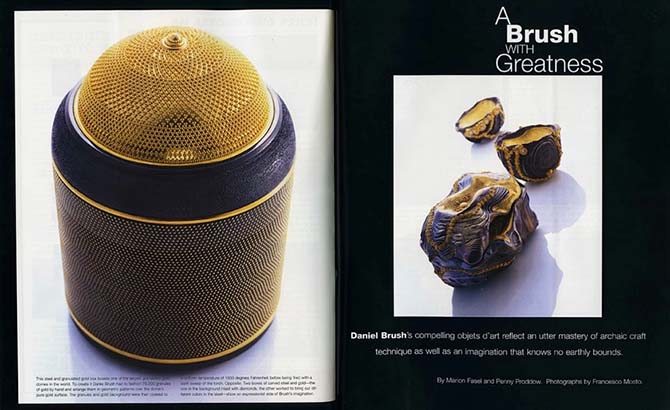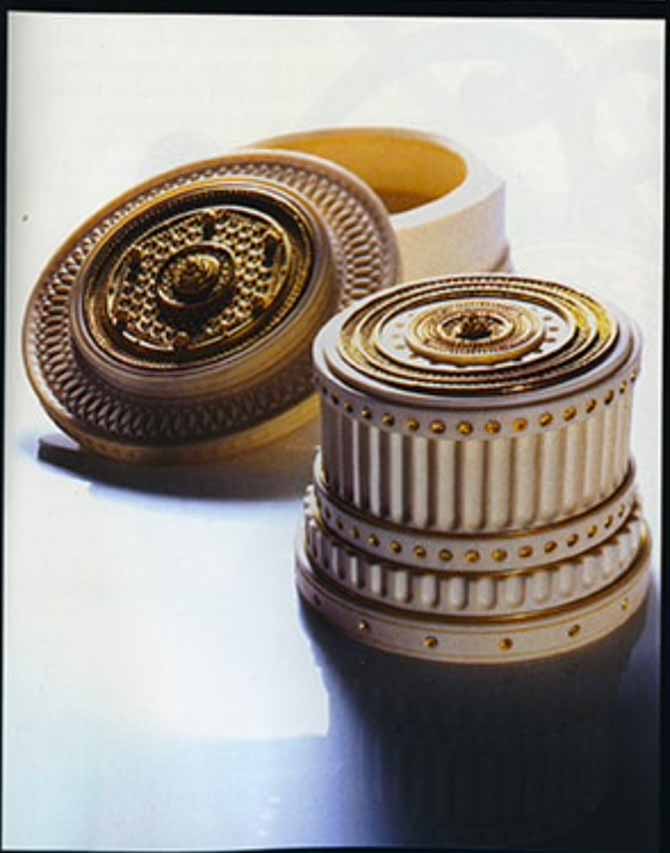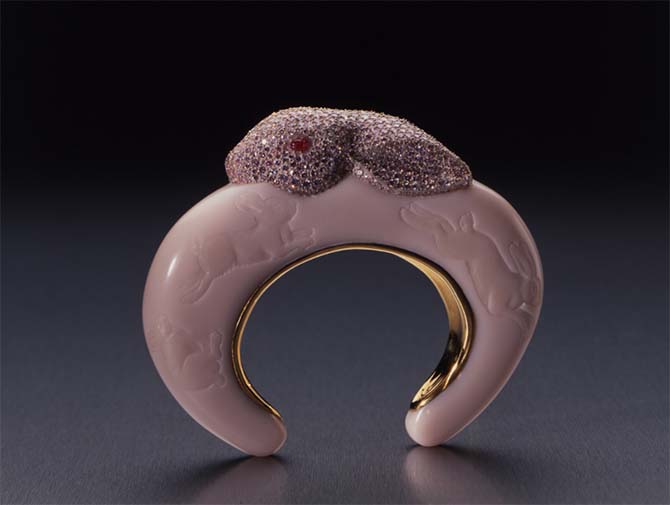“Approach! Commit! Execute!” Daniel Brush exclaimed in 2004 during an interview with CBS Sunday Morning, demonstrating his process with a dance-like movement. His words and actions perfectly captured his essence. Watching the segment recently brought back a flood of memories from the late 90s and early 2000s, when I had the privilege of knowing Daniel.
At the time, Daniel, a self-proclaimed hermit, was starting to emerge from his solitude under the encouragement of Ralph Esmerian, a gem dealer and jewelry collector who owned a vast collection of Daniel’s creations. I worked for Ralph along with Penny Proddow as a curator and archivist, giving us access to Daniel’s jewels and allowing us to interact with him when he visited our office at Rockefeller Center.
In our March/April 1997 article for Departures, titled “A Brush With Greatness,” Penny and I wrote about Daniel. I was thrilled to discover that the article is still available on his website. It was published a year before his first major museum exhibit, Gold Without Boundaries, and the excitement surrounding his work was palpable.

“Daniel gets inside the substance he deals with like Michelangelo gets into stone,” said Paul Gottlieb, the former editor-in-chief of Abrams. “Daniel is captivating and mesmerizing. He grabs your attention.” Sotheby’s David Bennett also shared how deeply moved people were when Daniel spoke about his work at an auction house in Geneva, with some being brought to tears.
Daniel was born in Cleveland, Ohio, in 1947. His father was a merchant, and his mother was a writer and photographer who frequently took him to museums. When Daniel was 12 years old, they visited London’s Victoria & Albert Museum, where he encountered a display of Etruscan goldwork for the first time. This experience had a profound impact on him. “My heart pounded like it has never since then,” Daniel explained. “I was obsessed with learning how it was made.”

After a brief stint in academia at Georgetown University, Daniel delved into goldwork and mastered the art of granulation like no other. The opening image of our Departures article showcased one of the largest granulated gold domes in the world. Measuring approximately five inches in diameter, it rested on a cylindrical steel box.
Granulation is a daring feat of technical skill. For the dome, Daniel meticulously arranged 78,000 granules in a geometric pattern across the curved surface. He revealed that mustering the courage to undertake the final stage—applying heat to the gold granules and background to achieve a uniform temperature and firing the object with a swift torch sweep—took almost as long as preparing the piece itself.
If anything went wrong, such as the granules falling off, months of work would be ruined in an instant. Describing the slim margin for error, Daniel said, “Success is achieved at 30 seconds, fails at 29, and melts at 31.”

In the 1990s, Daniel’s restless imagination led him to explore other obscure crafts. He became a master of turning, a technique popular among royalty in the 18th and 19th centuries. Daniel scoured the world to amass a remarkable collection of antique lathes, which he used to practice traditional turning. To operate them, he studied historical “How To” guides.
Creating intricate patterns on a highly detailed circular box made of Mastodon ivory required Daniel to simultaneous control three components: the foot lever for setting the gears in motion, the headstock for securing the Mastodon, and the tool rest that positioned the carving blade. His boxes were impressive displays of lathe work, featuring numerous patterns on multiple planes.

In the mid-1990s, alongside his work on granulation and turning, Daniel created his most whimsical pieces. This series came about after Ralph Esmerian gave him a parcel of pink diamonds straight from Australia’s Argyle mines to experiment with.
The Bunny Bangle, one of Daniel’s most renowned creations from this period, featured pink diamonds set in pink Bakelite. At first glance, it may seem like a playful fusion of costume and precious jewelry, but hidden within the pretty pink piece were exquisite details of craftsmanship. Daniel had to hollow out the Bakelite and pierce it with pink gold prongs to securely hold each diamond on the curved surface of the head.

Another treasure from this series is a pink diamond flamingo picture frame. This idea originated from conversations between Daniel and Ralph about the Duchess of Windsor’s flamingo brooch, as well as Ralph’s collection of pink diamonds stowed in his vault. The piece includes a matching Bakelite and pink diamond screwdriver used to open and close the frame.
Since his groundbreaking exhibition Gold Without Boundaries in 1998, Daniel continued to explore diverse themes in his work, cementing his status as a world-famous artist. He was the subject of numerous exhibits, including a retrospective at the Museum of Art and Design in 2012. Several books and catalogs have been dedicated to his exceptional creations. Most recently, Vivienne Becker penned Daniel Brush: Jewels Sculpture.
Daniel is survived by his wife, Olivia, who crafted boxes for his designs and served as his sounding board throughout their 50-year marriage. In a 2020 New York Times profile, Daniel affectionately referred to his wife with the Sanskrit word “Saham,” which translates to “I am She,” signifying their deep connection and shared dedication to his craft.
He also leaves behind his son, Silla Brush, whom I believe is a journalist. While Penny and I were working on the Departures article, Daniel proudly showed us an impressive Indian motorcycle he had assembled with his son when Silla was just 10 years old. Daniel believed it was important for his son to learn manual skills and craftsmanship. To quote Shakespeare, we shall not see another artist like him.

